Comparison of Linear and Nonlinear Controllers Applied to Path Following with Coaxial-Rotor MAV
Abstract
1. Introduction
2. Coaxial-Rotor MAV Mathematical Model
3. Linear and Nonlinear Controllers Design
3.1. Roll Angle Controllers Design
3.2. Pitch Angle Controllers Design
4. Simulation Results
4.1. Roll Angle Response
4.2. Pitch Angle Response
4.3. Trajectory Follow by the Coaxial-Rotor MAV
5. Discussion
Author Contributions
Funding
Institutional Review Board Statement
Informed Consent Statement
Data Availability Statement
Conflicts of Interest
Abbreviations
| MAV | Mini Aerial Vehicle |
| DOF | Degrees of Freedom |
| SO(3) | Special Orthogonal Group in 3D |
| PD | Proportional–Derivative |
| PID | Proportional–Integral–Derivative |
| SMC | Sliding Mode Control |
| 2SM | Second-order Sliding Mode |
| HOSM | High Order Sliding Mode |
References
- Prior, S.; Bell, C. Empirical Measurements of Small Aerial Co-Axial Rotor Systems. J. Sci. Innov. 2011, 1, 1–18. [Google Scholar]
- Ramesh, P.; Jeyan, J. Hover Performance Analysis of Coaxial Mini Unmanned Aerial Vehicle for Applications in Mountain Terrain. Vilnius Gedim. Tech.-Univ.-Aviat. 2022, 26, 112–123. [Google Scholar]
- Li, K.; Wei, Y.; Wang, W.; Deng, H. Longitudinal Attitude Control Decoupling Algorithm Based on the Fuzzy Sliding Mode of a Coaxial-Rotor UAV. Electronics 2019, 8, 107. [Google Scholar] [CrossRef]
- Wei, Y.; Chen, H.; Li, K.; Deng, H.; Li, D. Research on the Control Algorithm of Coaxial Rotor Aircraft based on Sliding Mode and PID. Electronics 2019, 8, 1428. [Google Scholar] [CrossRef]
- Singh, V.; Kanani, A.; Panchal, N.; Mathur, H. Dynamic Analysis of Coaxial Rotor Systems. Int. J. Mech. Prod. Eng. Res. Dev. 2020, 10, 1433–1444. [Google Scholar] [CrossRef]
- Wei, Y.; Deng, H.; Pan, Z.; Li, K.; Chen, H. Research on a Combinatorial Control Method for Coaxial Rotor Aircraft Based on Sliding Mode. Def. Technol. 2022, 18, 280–292. [Google Scholar] [CrossRef]
- Xu, C.; Su, C. Dynamic Observer-based H-infinity Robust Control for a Ducted Coaxial-rotor UAV. IET Control Theory Appl. 2022, 16, 1165–1181. [Google Scholar] [CrossRef]
- Koehl, A.; Rafaralahy, H.; Boutayeb, M.; Martinez, B. Aerodynamic Modelling and Experimental Identification of a Coaxial-Rotor UAV. J. Intell. Robot. Syst. 2020, 68, 53–68. [Google Scholar] [CrossRef]
- Denton, H.; Benedict, M.; Kang, H. Design, development, and flight testing of a tube-launched coaxial-rotor based micro air vehicle. Int. J. Micro Air Veh. 2022, 14, 17568293221117189. [Google Scholar] [CrossRef]
- Chen, L.; Xiao, J.; Zheng, Y.; Alagappan, N.; Feroskhan, M. Design, Modeling, and Control of a Coaxial Drone. IEEE Trans. Robot. 2024, 40, 1650–1663. [Google Scholar] [CrossRef]
- Xu, J.; Hao, Y.; Wang, J.; Li, L. The Control Algorithm and Experimentation of Coaxial Rotor Aircraft Trajectory Tracking Based on Backstepping Sliding Mode. Aerospace 2021, 8, 337. [Google Scholar] [CrossRef]
- Glida, H.; Chelihi, A.; Abdou, L.; Sentouh, C.; Perozzi, G. Trajectory Tracking Control of a Coaxial Rotor Drone: Time-delay Estimation-based Optimal Model-free Fuzzy Logic Approach. ISA Trans. 2023, 137, 236–247. [Google Scholar] [CrossRef]
- Goldstein, H.; Poole, C.; Safko, J. Classical Mechanics; Adison-Wesley: Boston, MA, USA, 1983. [Google Scholar]
- Castillo, P.; Lozano, R.; Dzul, A. Modelling and Control of Mini-Flying Machines; Springer: London, UK, 2005. [Google Scholar]
- Garcia, L.; Dzul, A.; Lozano, R.; Pégard, A. Quad Rotorcraft Control: Vision-Based Hovering and Navigation; Springer: London, UK, 2013. [Google Scholar]
- O’Reilly, O.M. Intermediate Dynamics for Engineers; Cambridge University Press: Cambridge, UK, 2020. [Google Scholar]
- Ardema, M.D. Newton-Euler Dynamics; Springer: Boston, MA, USA, 2005. [Google Scholar]
- Craig, J.J. Introduction to Robotics Mechanics and Control, 3rd ed.; Pearson Education International: Upper Saddle River, NJ, USA, 2005. [Google Scholar]
- Stengel, R.F. Flight Dynamics; Princeton University Press: Princeton, NJ, USA, 2004. [Google Scholar]
- Cook, M. Flight Dynamics Principles, 2nd ed.; Elsevier: Amsterdam, The Netherlands, 2007. [Google Scholar]
- Stevens, B.; Lewis, F.; Johnson, E. Aircraft Control and Simulation, 3rd ed.; Jhon Wiley and Sons: Hoboken, NJ, USA, 2015. [Google Scholar]
- Mclean, D. Automatic Flight Control Systems; Prentice Hall International: Hoboken, NJ, USA, 1990. [Google Scholar]
- Espinoza-Fraire, T.; Dzul, A.; Parada, R.; Sáenz, A. Design of Control Laws and State Observers for Fixed-WIng UAVs: Simulation and Experimental Approaches; Elsevier: London, UK, 2023. [Google Scholar]
- Kelly, R.; Santibañez, V.; Loría, L. Control of Robot Manipulators in Joint Space; Springer: New York, NY, USA, 2005. [Google Scholar]
- Ogata, K. Modern Control Engineering, 5th ed.; Prentice Hall: Englewood Cliffs, NJ, USA, 2009. [Google Scholar]
- Teel, A. Global stabilization and restricted tracking for multiple integrators with bounded controls. Syst. Control Lett. 1992, 18, 165–171. [Google Scholar] [CrossRef]
- Khalil, H. Nonlinear Systems, 3rd ed.; Prentice Hall: Englewood Cliffs, NJ, USA, 1995. [Google Scholar]
- Shtessel, Y.; Edwards, C.; Fridman, L.; Levant, A. Sliding Mode Control and Observation; Birkhäuser: Brooklyn, NY, USA, 2015. [Google Scholar]
- Levant, A. Robust exact differentition via sliding mode technique. Automatica 1998, 34, 379–384. [Google Scholar] [CrossRef]
- Levant, A. Construction principles of 2-sliding mode design. Automatica 2007, 43, 576–586. [Google Scholar] [CrossRef]
- Levant, A. Higher-order sliding modes, differentiation and output-feedback control. Int. J. Control 2003, 76, 924–941. [Google Scholar] [CrossRef]
- Åström, K.; Wittenmark, B. Adaptive Control, 2nd ed.; Prentice Hall: Englewood Cliffs, NJ, USA, 1994. [Google Scholar]
- Kristić, M.; Kanellakopoulos, I.; Kokotović, P. Nonlinear and Adaptive Control Design; John Wiley and Sons: Hoboken, NJ, USA, 1995. [Google Scholar]
- Wang, W.; Wen, C.; Zhou, J. Adaptive Backstepping Control of Uncertain Systems with Actuator Failures, Subsystem Interactions, and Nonsmooth Nonlinearities; CRC Press: Abingdon, UK, 2017. [Google Scholar]


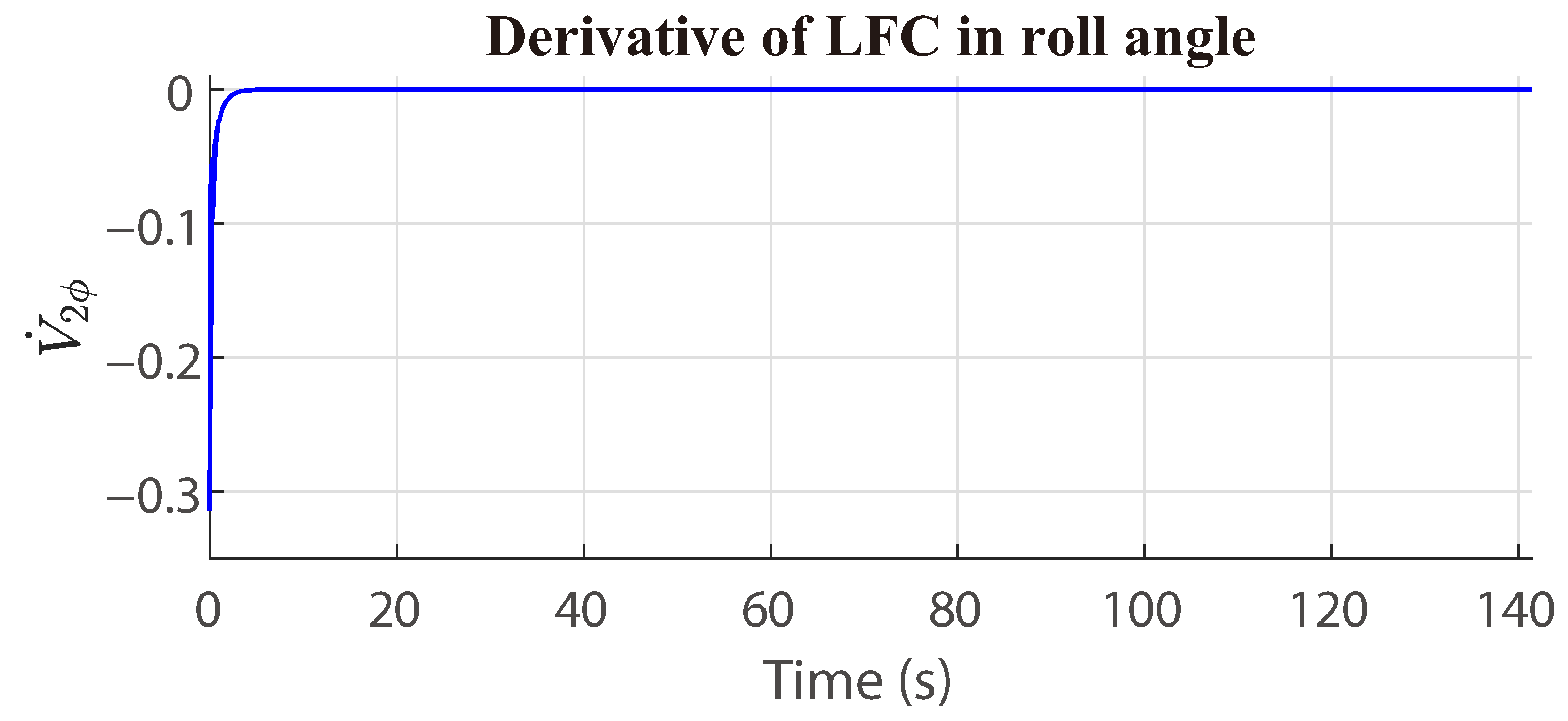

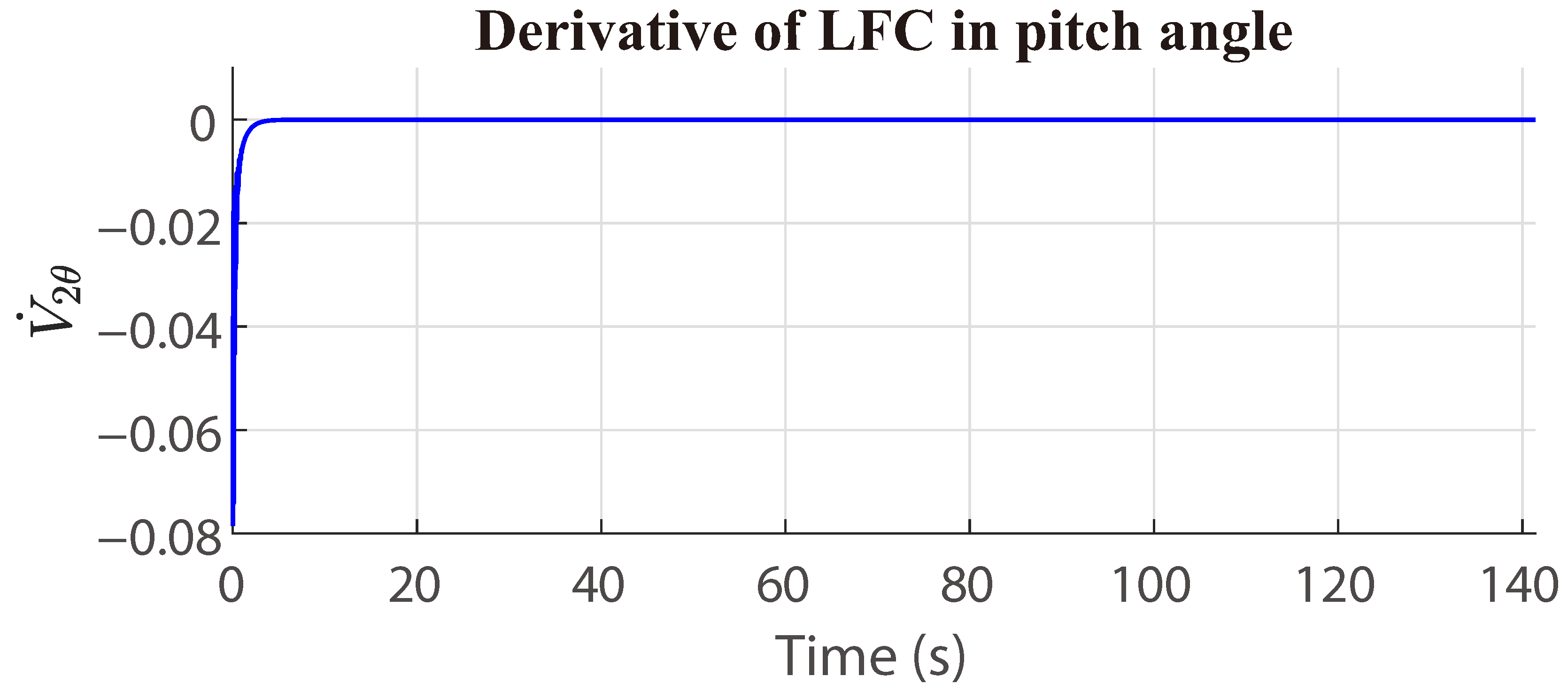
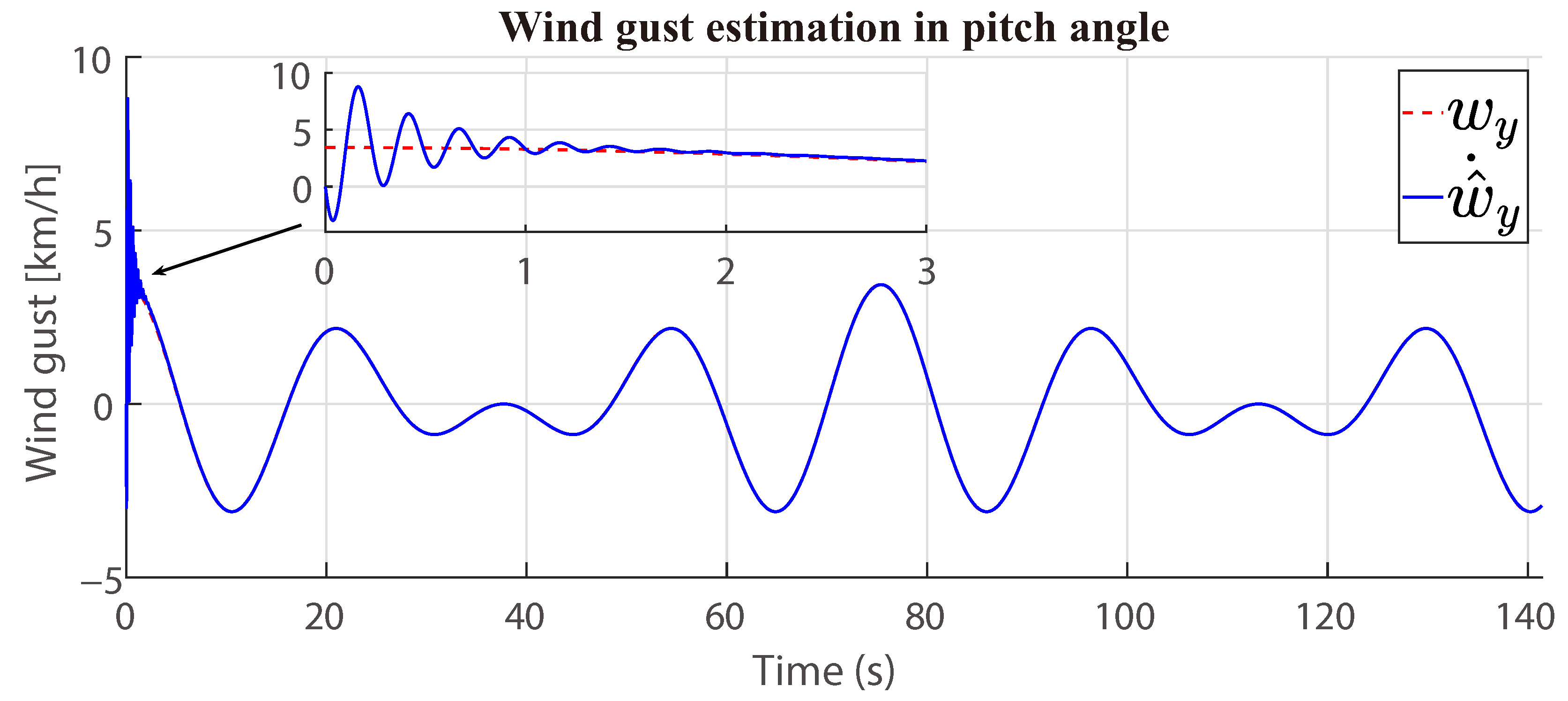
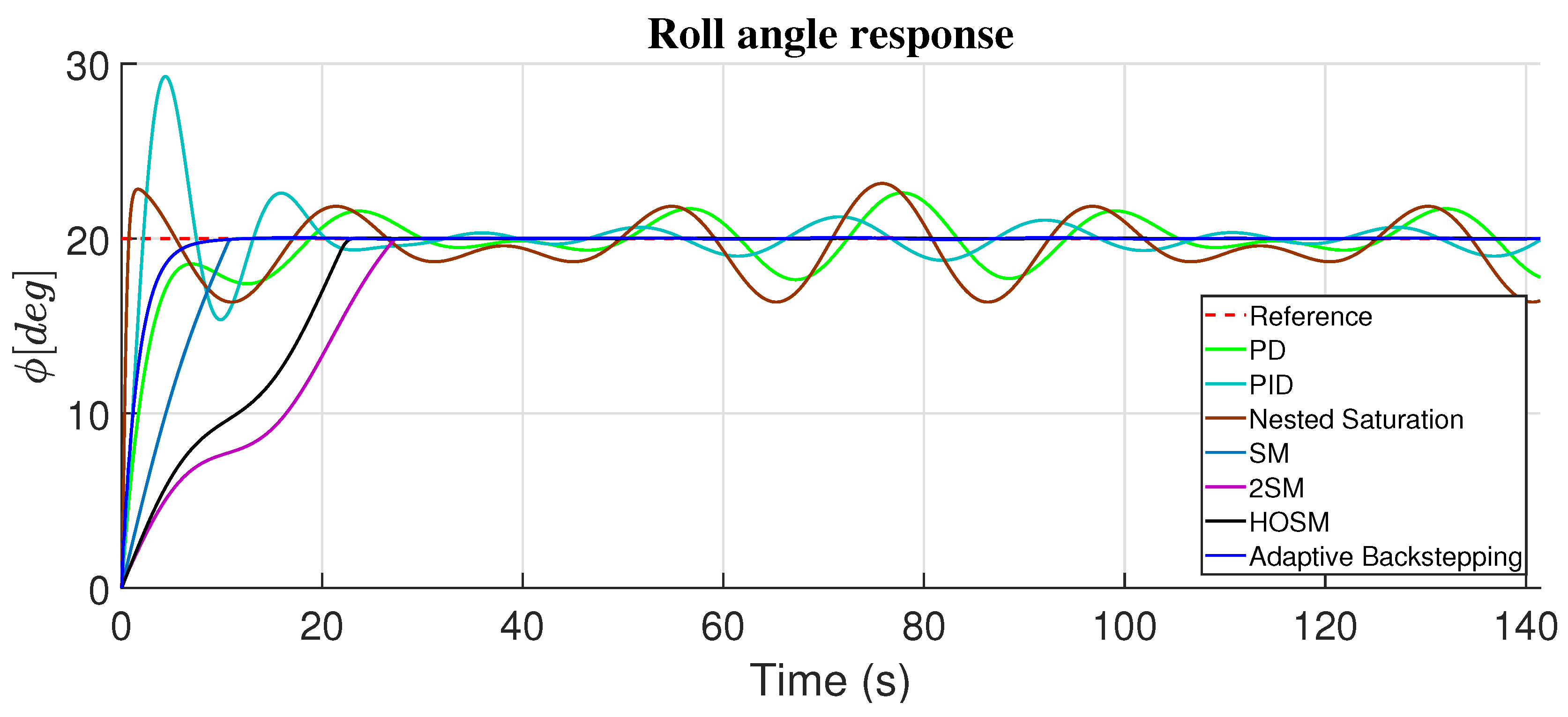
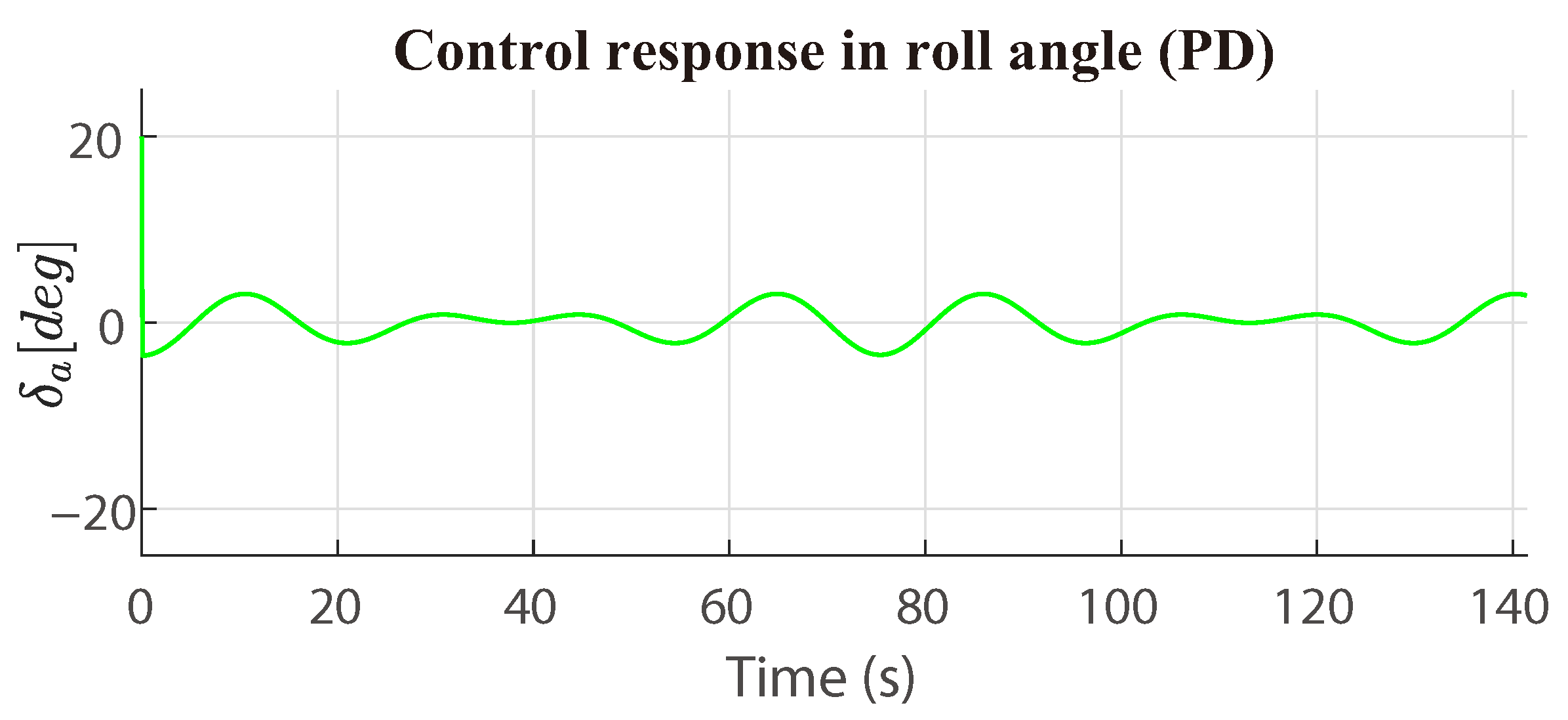

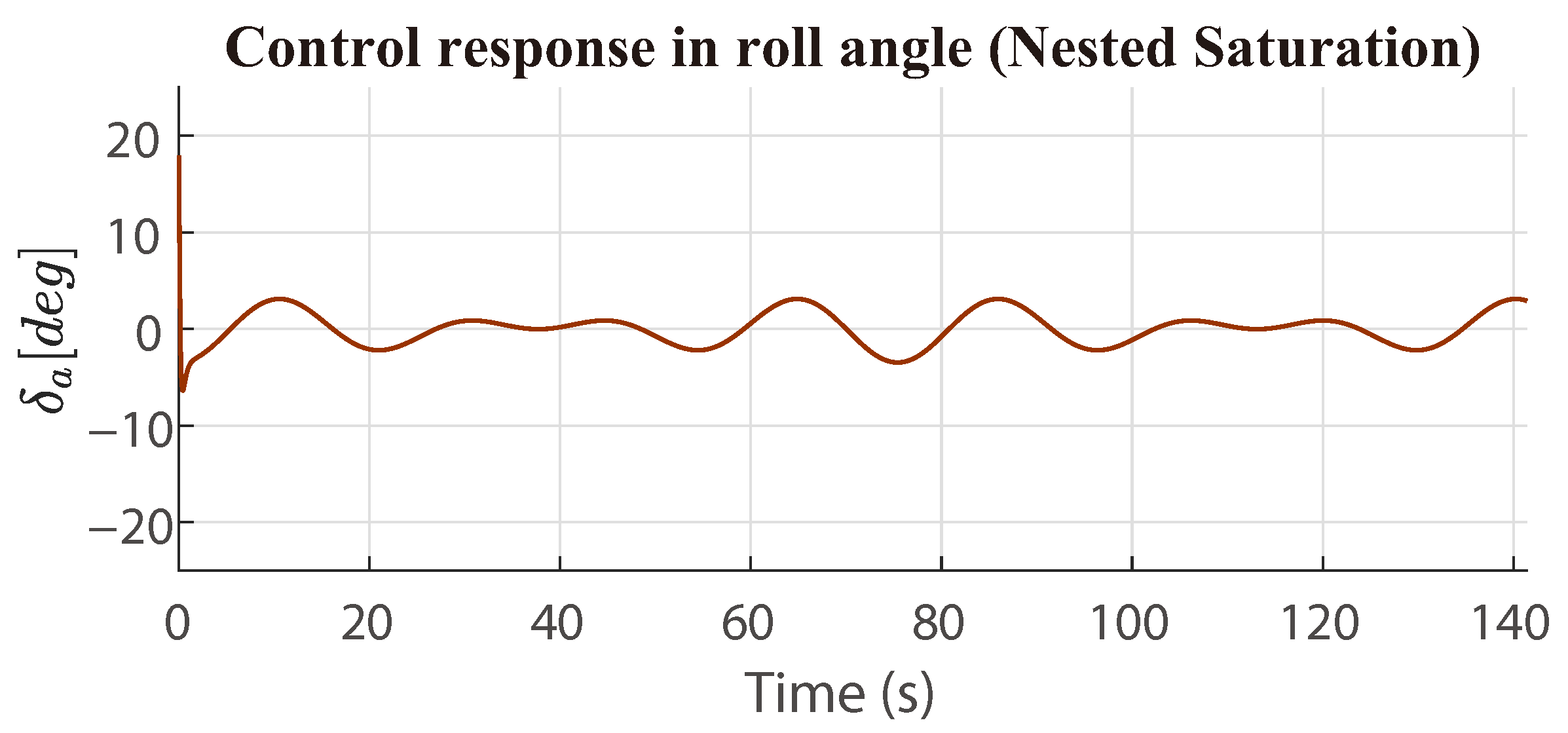
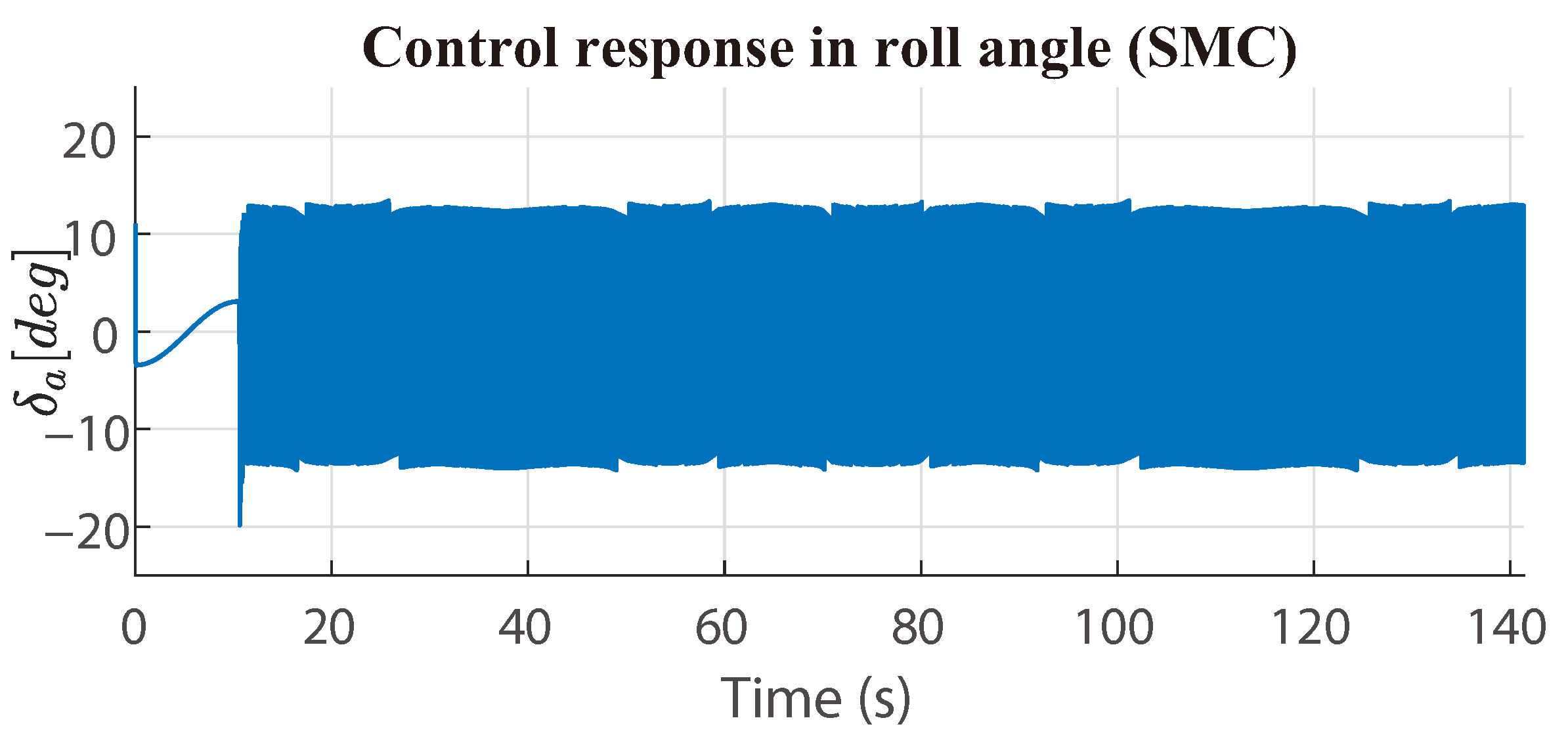


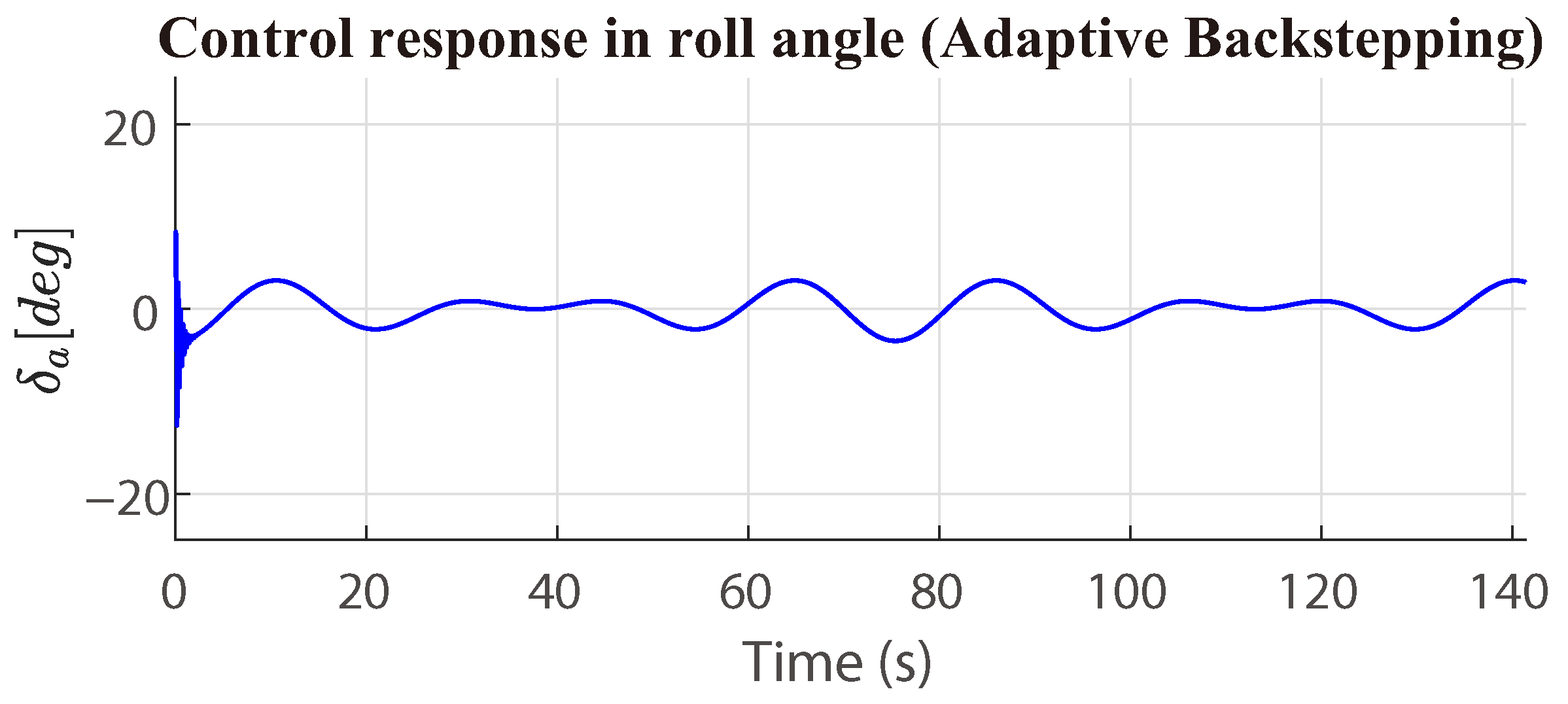



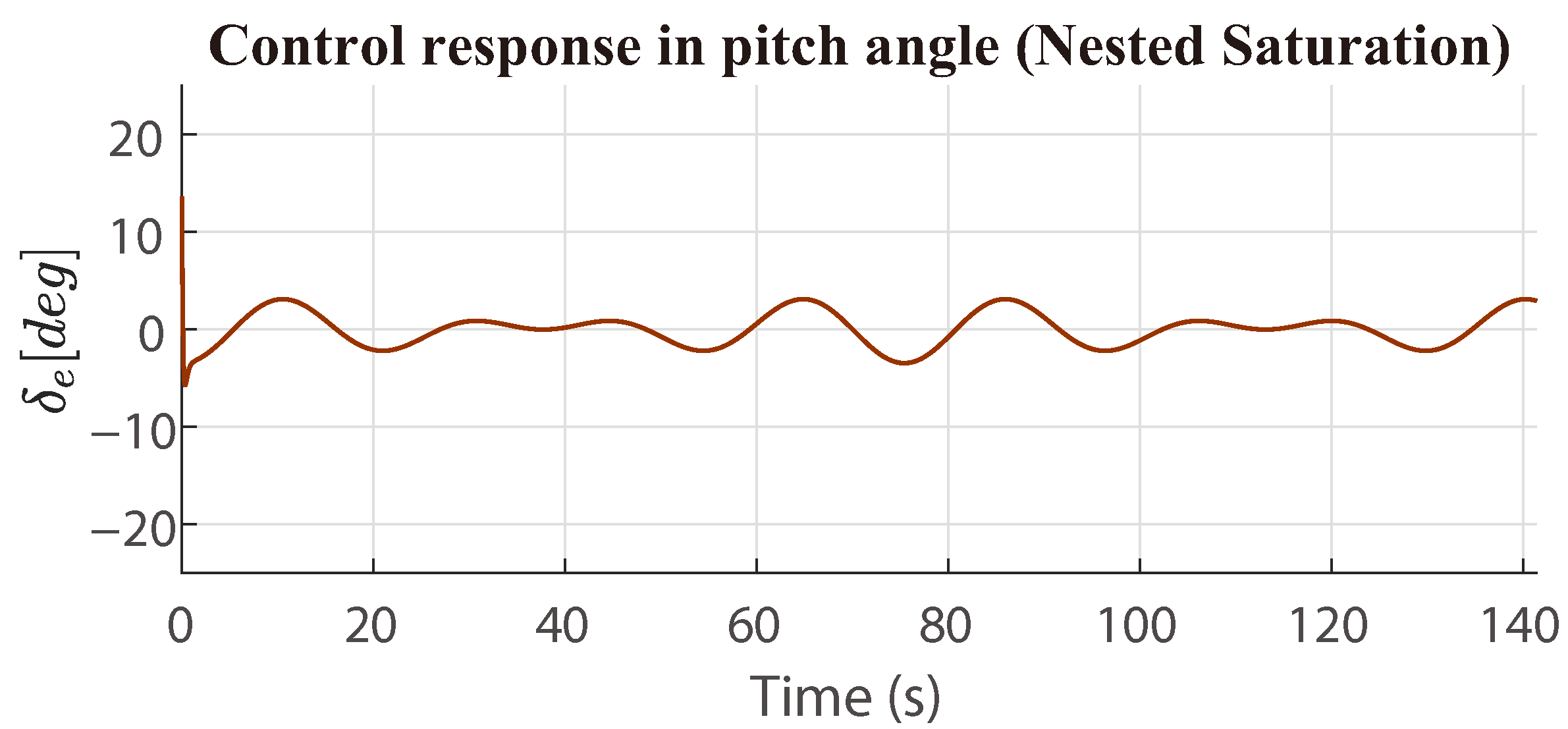

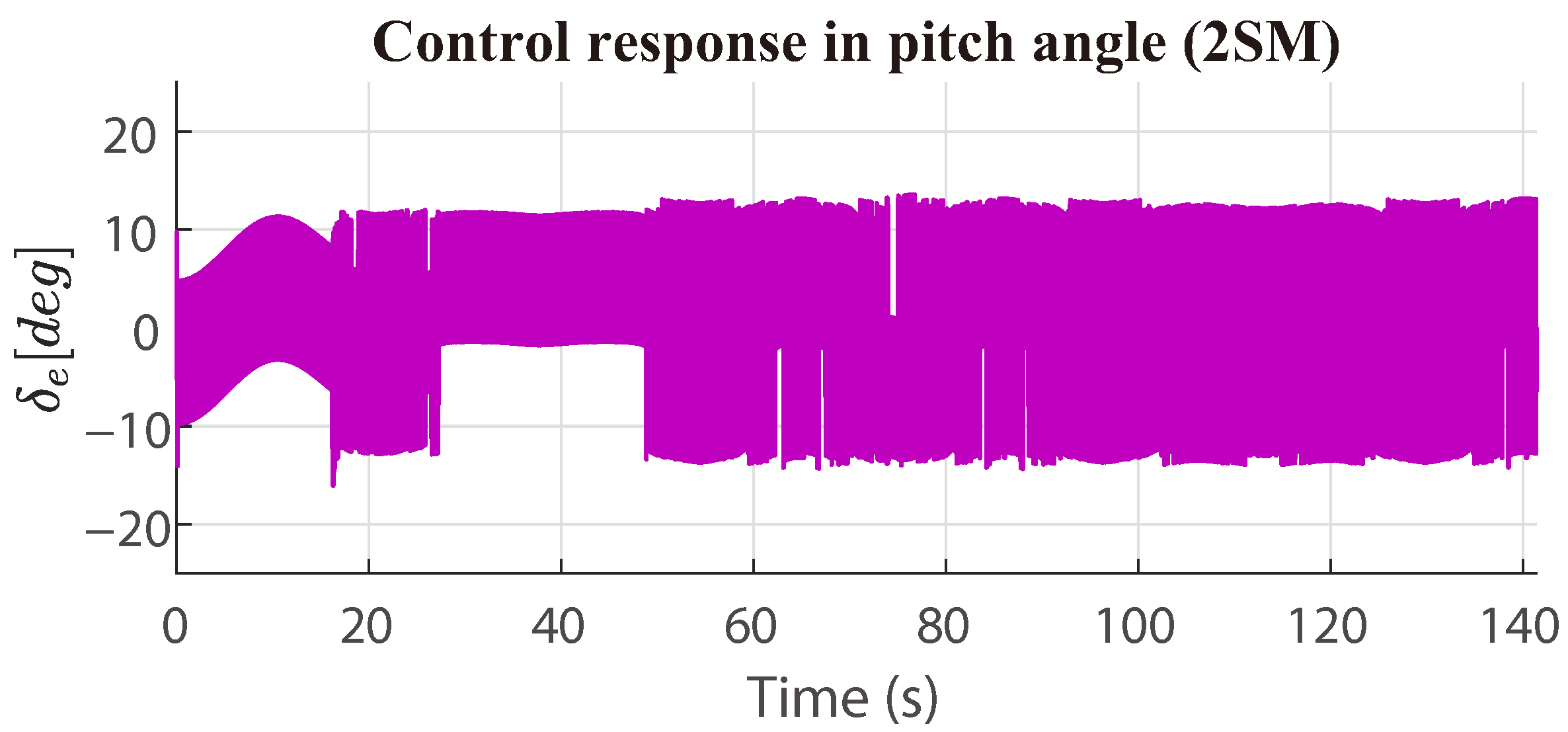

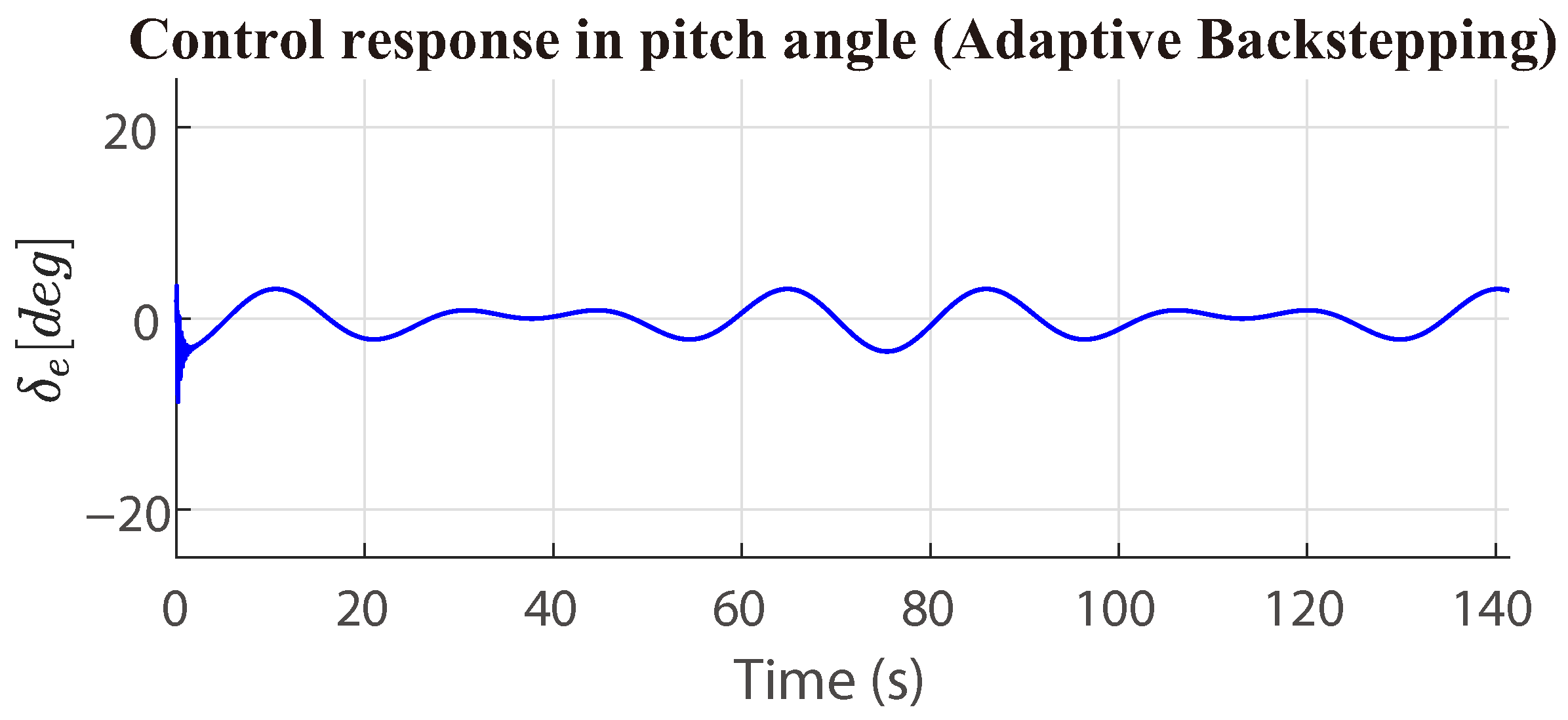

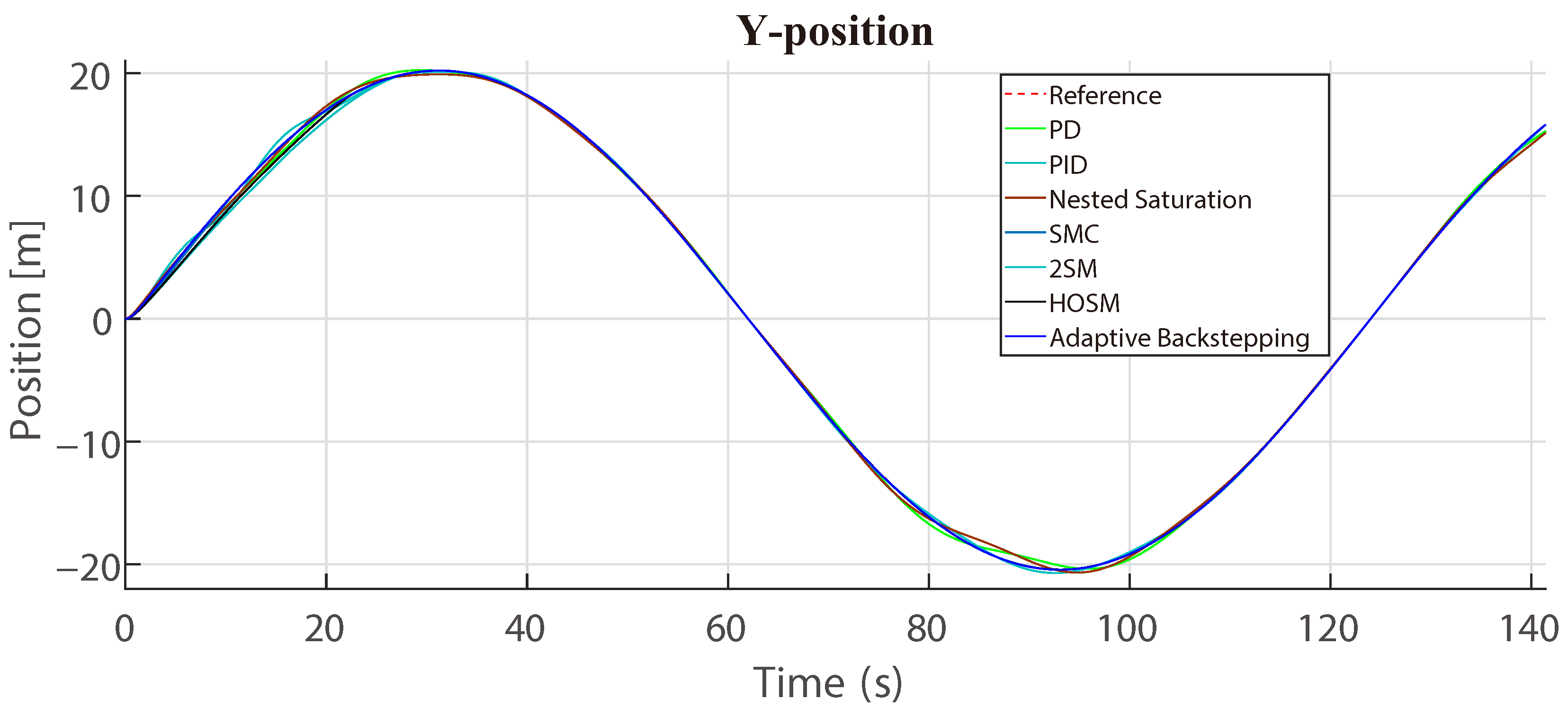
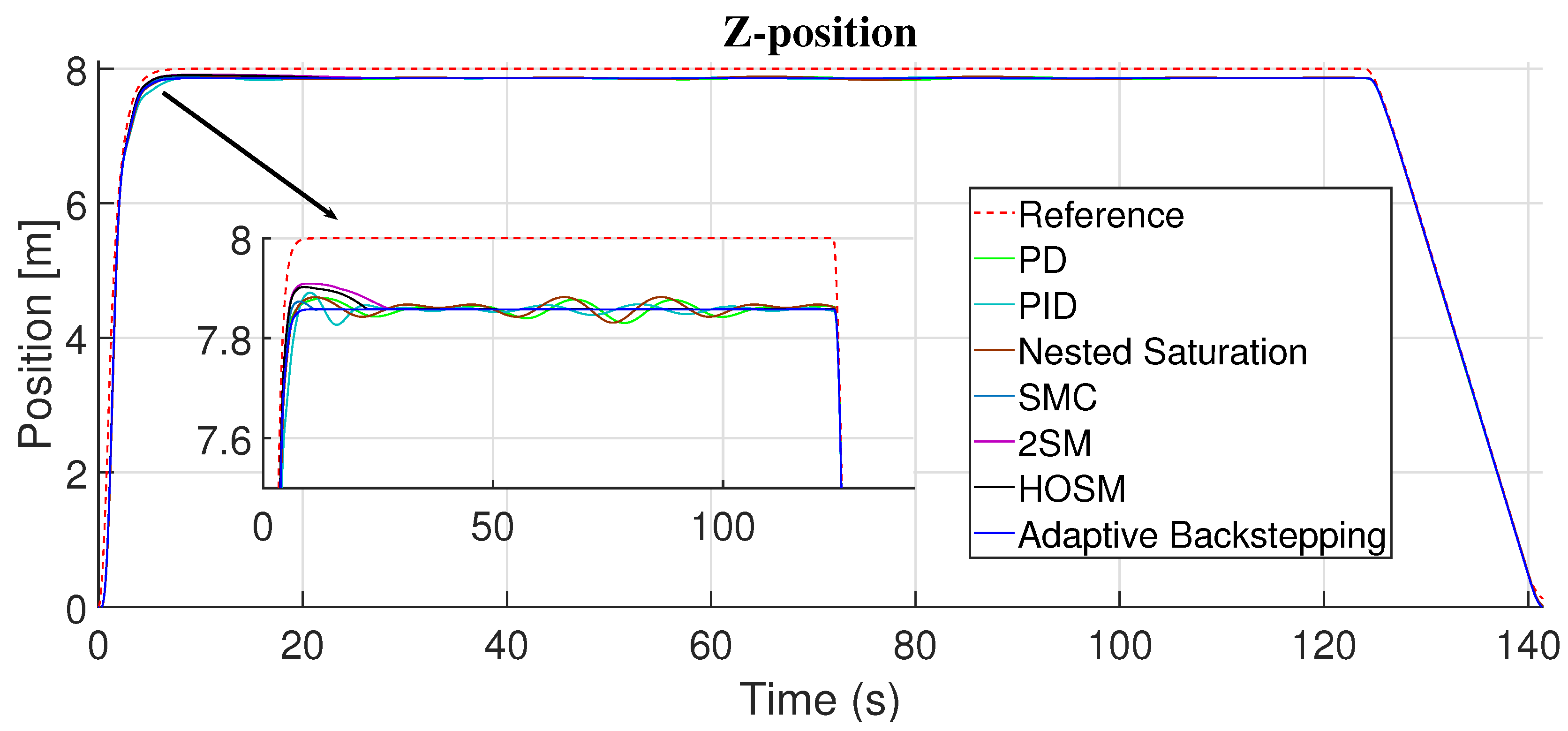

| Roll Angle () | ||
|---|---|---|
| PD | 2.2186 | 1.6902 |
| PID | 2.1366 | 1.6902 |
| Nested Saturation | 1.9771 | 1.7372 |
| Sliding Mode | 2.9122 | 11.8892 |
| Second-order Sliding Mode | 4.9947 | 6.2838 |
| High-Order Sliding Mode | 4.4072 | 5.6993 |
| Adaptive Backstepping | 1.5271 | 1.7194 |
| Pitch Angle () | ||
|---|---|---|
| PD | 2.0078 | 1.6830 |
| PID | 2.6340 | 1.6826 |
| Nested Saturation | 1.2741 | 1.7097 |
| Sliding Mode | 0.9995 | 12.1660 |
| Second-order Sliding Mode | 1.5125 | 6.3147 |
| High-Order Sliding Mode | 1.3462 | 5.9203 |
| Adaptive Backstepping | 0.7598 | 1.6931 |
Disclaimer/Publisher’s Note: The statements, opinions and data contained in all publications are solely those of the individual author(s) and contributor(s) and not of MDPI and/or the editor(s). MDPI and/or the editor(s) disclaim responsibility for any injury to people or property resulting from any ideas, methods, instructions or products referred to in the content. |
© 2025 by the authors. Licensee MDPI, Basel, Switzerland. This article is an open access article distributed under the terms and conditions of the Creative Commons Attribution (CC BY) license (https://creativecommons.org/licenses/by/4.0/).
Share and Cite
Fraire, A.T.E.; Esqueda, J.A.S.; Esparza, I.G.; Sakanassi, J.A.O. Comparison of Linear and Nonlinear Controllers Applied to Path Following with Coaxial-Rotor MAV. Automation 2025, 6, 66. https://doi.org/10.3390/automation6040066
Fraire ATE, Esqueda JAS, Esparza IG, Sakanassi JAO. Comparison of Linear and Nonlinear Controllers Applied to Path Following with Coaxial-Rotor MAV. Automation. 2025; 6(4):66. https://doi.org/10.3390/automation6040066
Chicago/Turabian StyleFraire, Arturo Tadeo Espinoza, José Armando Sáenz Esqueda, Isaac Gandarilla Esparza, and Jorge Alberto Orrante Sakanassi. 2025. "Comparison of Linear and Nonlinear Controllers Applied to Path Following with Coaxial-Rotor MAV" Automation 6, no. 4: 66. https://doi.org/10.3390/automation6040066
APA StyleFraire, A. T. E., Esqueda, J. A. S., Esparza, I. G., & Sakanassi, J. A. O. (2025). Comparison of Linear and Nonlinear Controllers Applied to Path Following with Coaxial-Rotor MAV. Automation, 6(4), 66. https://doi.org/10.3390/automation6040066








